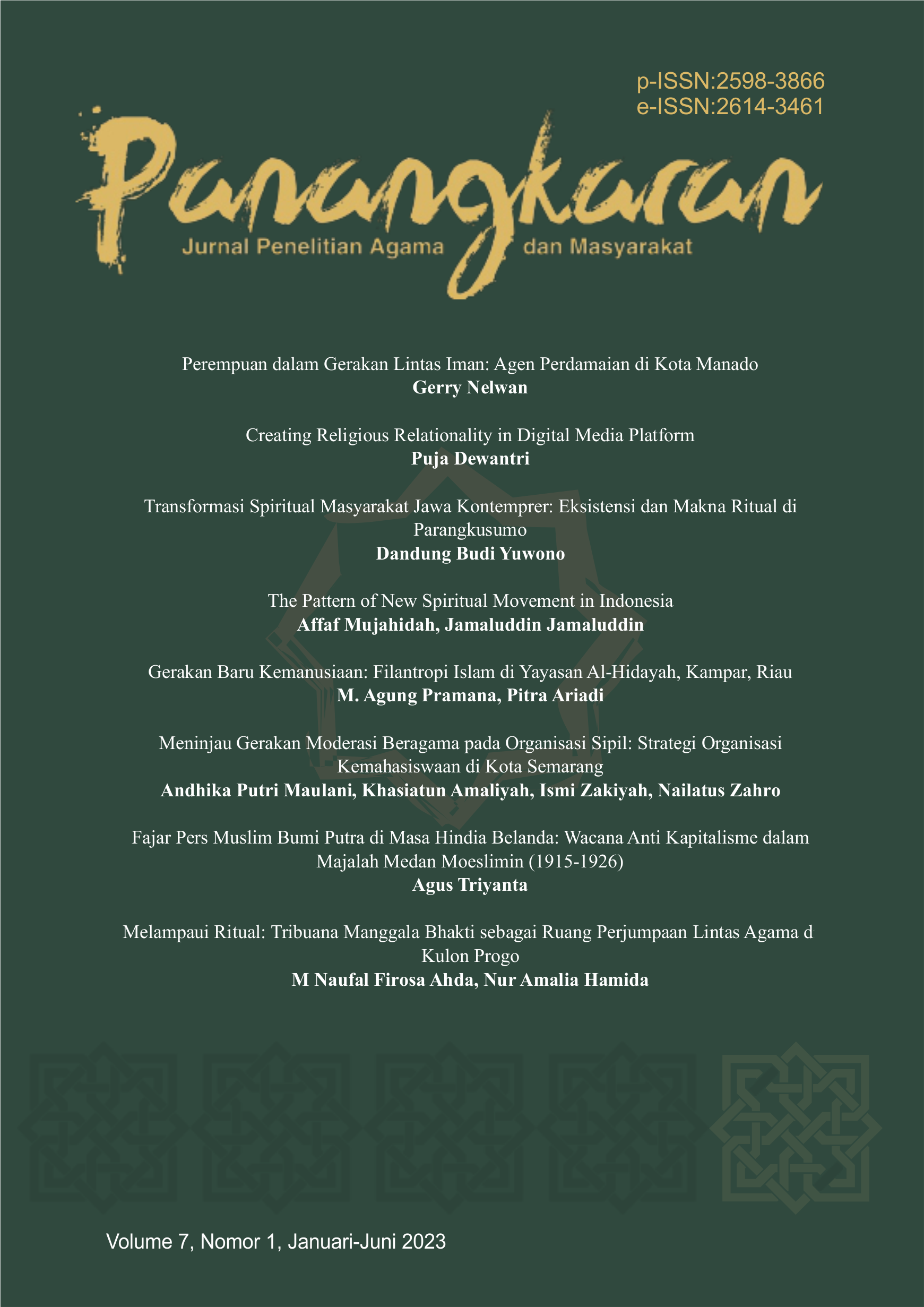Melampaui Ritual
Tribuana Manggala Bhakti sebagai Ruang Perjumpaan Lintas Agama di Kulon Progo
DOI:
https://doi.org/10.14421/panangkaran.v7i1.3427Keywords:
Tribuana Manggala Bhakti, Encounter Spaces, Interreligious engagementAbstract
Interreligious dialogue is still often characterised as a form of dialogue that is ideally organised formally and represented by religious leaders, elites, and government officials. Dialogue, which tends to be rigid and limit access to most of the community, is a challenge in the context of interreligious dialogue in presenting a more inclusive space that allows for broader community involvement. This research aims to explore interreligious relations through the Tribuana Manggala Bhakti tradition in the Jatimulyo Village community, Kulon Progo, Yogyakarta Special Region. A qualitative research method with a case study approach was used as a tool for obtaining data in the field. The subjects in this study amounted to four people who came from among residents, interfaith youth, religious leaders, and community leaders. The results of the study show that the Tribuana Manggala Bhakti tradition has transformed its meaning from a symbol of Buddhist tradition to a social symbol of society in general, so that it goes beyond its functions as a ritual. The shift in meaning in the tradition is due to several factors, namely: the support of the village government, having local wisdom values that are relevant to community life, and the emergence of enthusiasm and community participation in the success of the event. The challenges currently faced are related to the participation of the village youth, who are gradually decreasing in their participation to maintain and be involved, so that in the future, the tradition requires the role of youth on an ongoing basis in an effort to maintain that the space for interfaith encounters still exists in Jatimulyo Village.
[Dialog lintas agama masih sering dipahami sebagai suatu cara yang idealnya dilakukan secara formal dan diwakili oleh para pemuka agama dan pejabat pemerintah. Dialog yang cenderung kaku dan membatasi akses sebagian besar masyarakat, menjadi tantangan tersendiri pada konteks dialog lintas agama dalam menghadirkan ruang yang lebih inklusif serta memungkinkan keterlibatan masyarakat secara luas. Penelitian ini bertujuan mengkaji bagaimana tradisi Tribuana Manggala Bhakti muncul dan bertransformasi menjadi kegiatan serta ruang perjumpaan lintas agama masyasrakat Desa Jatimulyo. Metode penelitian kualitatif dengan pendekatan studi kasus digunakan sebagai alat dalam mendapatkan data di lapangan. Subjek dalam penelitian ini berjumlah empat orang yang berasal dari kalangan warga, pemuda lintas agama, tokoh agama, dan tokoh masyarakat. Hasil studi menunjukkan bahwa tradisi Tribuana Manggala Bhakti mengalami pergeseran makna, dari simbol tradisi warga agama Buddha ke simbol sosial masyarakat secara umum. Bergesernya makna dalam tradisi tersebut dikarenakan beberapa faktor yakni: adanya dukungan dari kalangan pemerintah desa, memiliki nilai-nilai kearifan lokal yang relevan dengan kehidupan masyarakat, dan munculnya antusias serta keikutsertaan masyarakat dalam menyukseskan acara tersebut. Adapun tantangan yang saat ini dihadapi terkait denganadalah soal keikutsertaan para pemuda desa yang lambat laun mengalami penurunan dalam partisipasinya untuk merawat dan terlibat, sehingga kedepannya tradisi tersebut memerlukan peran pemuda secara berkelanjutan dalam upaya menjaga agar ruang perjumpaan lintas agama masih tetap ada di Desa Jatimulyo]
Downloads
References
Anttonen, P., Forselles, C. af, & Salmi-Niklander, K. (Eds.). (2018). Oral tradition and book culture. Finnish Literature Society (SKS).
Appleby, R. S. (2000). The ambivalence of the sacred: Religion, violence, and reconciliation. Rowman & Littlefield Publishers.
Aulia, G. R., & Nawas, S. S. A. (2021). Implementasi Nilai-Nilai Toleransi Umat Bergama pada Upacara Rambu Solo di Tana Toraja. Jurnal Ushuluddin: Media Dialog Pemikiran Islam, 23(2). https://doi.org/10.24252/jumdpi.v23i2.23115
Ayoub, M. (2004). Christian-Muslim Dialogue: Goals and Obstacles. The Muslim World, 94(3), 313–319. https://doi.org/10.1111/j.1478-1913.2004.00055.x
Cornelio, J. S., & Salera, T. A. E. (2012). Youth in interfaith dialogue: Intercultural understanding and its implications on education in the Philippines. Innovación Educativa, 12.
Durkheim, É., Cosman, C., & Cladis, M. S. (2008). The Elementary Forms of Religious Life. Oxford University Press.
Esposito, J. L., Fasching, D. J., & Lewis, T. (2018). World religions today (Sixth edition). Oxford University Press.
Giordan, G., & Lynch, A. P. (Eds.). (2019). Beyond Interreligious Dialogue: Oral-Based Interreligious Engagements in Indonesia. In Volume 10: Interreligious Dialogue (pp. 70–90). BRILL. https://doi.org/10.1163/9789004401266_006
Halbwachs, M., & Coser, L. A. (1992). On collective memory. University of Chicago Press.
Harno, S., & Maharani, S. D. (2023). Kajian Aksiologis Upacara Tribuana Manggala Bakti. Jurnal Filsafat Indonesia, 6(1), 10–20. https://doi.org/10.23887/jfi.v6i1.42567
Hirst, W., & Manier, D. (2008). Towards a psychology of collective memory. Memory, 16(3), 183–200. https://doi.org/10.1080/09658210701811912
Knitter, P. F. (2013). Inter‐Religious Dialogue and Social Action. In C. Cornille (Ed.), The Wiley‐Blackwell Companion to Inter‐Religious Dialogue (1st ed., pp. 133–148). Wiley. https://doi.org/10.1002/9781118529911.ch9
Lattu, I. Y. M. (2019). Orality and Ritual in Collective Memory: A Theoretical Discussion. Jurnal Pemikiran Sosiologi, 6(2), 94. https://doi.org/10.22146/jps.v6i2.51580
Marjianto, L., & Prasetyo, L. (2019). Analisis Upacara Tribuana Manggala Bhakti (Studi Interaksionisme Simbolik Umat Buddha Desa Jatimulyo Kecamatan Girimulyo Kabupaten Kulon Progo). Jurnal Agama Buddha Dan Ilmu Pengetahuan, 133–152.
Moyaert, M. (Ed.). (2019). Interreligious Relations and the Negotiation of Ritual Boundaries: Explorations in Interrituality. Springer International Publishing. https://doi.org/10.1007/978-3-030-05701-5
Muanifah, M. (2017). Nilai-Nilai Budaya Jawa Terhadap Toleransi (Studi Kasus Masyarakat di Desa Besowo, Kecamatan Kepung, Kabupaten Kediri) [Undergraduate, IAIN Kediri]. http://etheses.iainkediri.ac.id/99/
Mukti, K. W. (2020). Wacana Buddha-Dharma (5th ed.). Karayaniya.
Mushengyezi, A. (2007). Graham Furnis, Orality: The power of the spoken word. Language in Society, 36(04), 605. https://doi.org/10.1017/S0047404507070467
Muslim, A. (2019). The Harmony Taste Of Bakar Batu Tradition On Papua Land. Heritage of Nusantara: International Journal of Religious Literature and Heritage, 8(1), 100–147. https://doi.org/10.31291/hn.v8i1.545
Nora, P. (Ed.). (1998). Realms of memory. volume 3: Symbols / under the direction of Pierre Nora ; english-language edition edited by Lawrence D. Kritzman (L. D. Kritzman, Trans.). Columbia University Press.
Ong, W. J. (2002). Orality and Literacy: The Technologizing of the Word. Routledge.
Phan, P. C. (2003). In our own tongues: Perspectives from Asia on mission and inculturation. Orbis Books.
Putnam, R. D. (1994). Social Capital and Public Affairs. Bulletin of the American Academy of Arts and Sciences, 47(8), 5. https://doi.org/10.2307/3824796
Suharno, S., & Sartini, S. (2022). Tribuana Manggala Bakti: Menjaga Lingkungan Alam Menoreh dalam Perspektif Fritjof Capra. Jurnal SMART (Studi Masyarakat, Religi, dan Tradisi), 8(2), 275–286. https://doi.org/10.18784/smart.v8i2.1689
Sweeney, A. (1987). A full hearing: Orality and literacy in the Malay world. University of California Press.
Swidler, L. (2013). The History of Inter‐Religious Dialogue. In C. Cornille (Ed.), The Wiley‐Blackwell Companion to Inter‐Religious Dialogue (1st ed., pp. 1–19). Wiley. https://doi.org/10.1002/9781118529911.ch1
Swidler, L. (2014). The Dialogue Decalogue: Ground Rules for Interreligious, Interideological Dialogue. In L. Swidler, Dialogue for Interreligious Understanding (pp. 47–51). Palgrave Macmillan US. https://doi.org/10.1057/9781137470690_6
Tadjoeddin, M. (2005). Civil Society Engagement and Communal Violence: Reflections of Various Hypotheses in the Context of Indonesia.
Tönnies, F., 1855-1936. (1957). Community & society (Gemeinschaft und Gesellschaft). East Lansing : Michigan State University Press, [1957]. https://search.library.wisc.edu/catalog/999468572802121
Wegner, D. M., Giuliano, T., & Hertel, P. T. (1985). Cognitive Interdependence in Close Relationships. In W. Ickes (Ed.), Compatible and Incompatible Relationships (pp. 253–276). Springer New York. https://doi.org/10.1007/978-1-4612-5044-9_12
Downloads
Published
How to Cite
Issue
Section
License
Copyright (c) 2023 M Naufal Firosa Ahda, Nur Amalia Hamida

This work is licensed under a Creative Commons Attribution-NonCommercial-NoDerivatives 4.0 International License.
JURNAL PANANGKARAN disebarluaskan dengan lisensi Creative Commons Attribution-NonCommercial-NoDerrivatives 4.0 International License.
 Abstract Viewed = 187 times
|
Abstract Viewed = 187 times
|
 pdf downloaded = 134 times
pdf downloaded = 134 times












